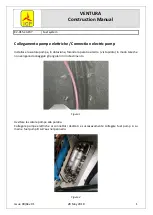
15
The following is a turn performance diagram for a C-130H at sea level, standard day. 130,000
lbs with thrust set to 1049° C, with contours of specific excess power overlaid.
The highest specific excess power contours are on the left hand side of the aircraft’s envelope
near the lift limit (stall speed). The minimum sustainable turn radius is at point “B,’ about 1,300
ft (about 12 ship lengths). This is also the point of maximum sustainable turn rate (12°/sec) in
level flight. This results in excellent slow speed maneuverability.
The C-130 maximum effort takeoff operations are a result of its specific excess power
characteristics. Maximum effort takeoff operations are conducted at significantly slower
airspeeds than normal takeoffs to take advantage of the greater specific excess power. The
maximum effort speeds provide for improved climb capability at the expense of safety by, in
some cases, ignoring minimum control speeds. In the C-130, the actual best angle of climb
airspeed (used for clearing obstacles after takeoff) is just above the stall speed. Speeds this slow
are not operationally practical, so some speed increment is used at the expense of climb angle.
The C-130 climbout performance is a marked contrast to a typical swept - wing jet aircraft.
Using the KC-135R as a representative example of a swept - wing jet aircraft, the following is a
diagram of speed/configuration verses climb rate:












































